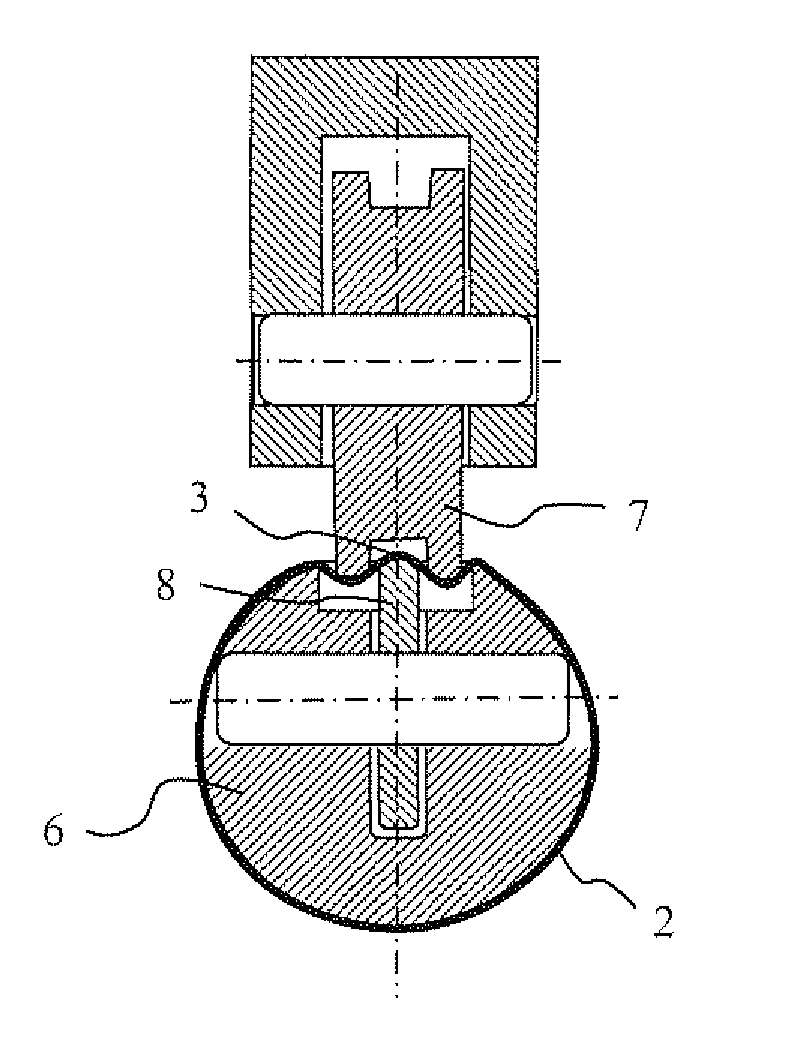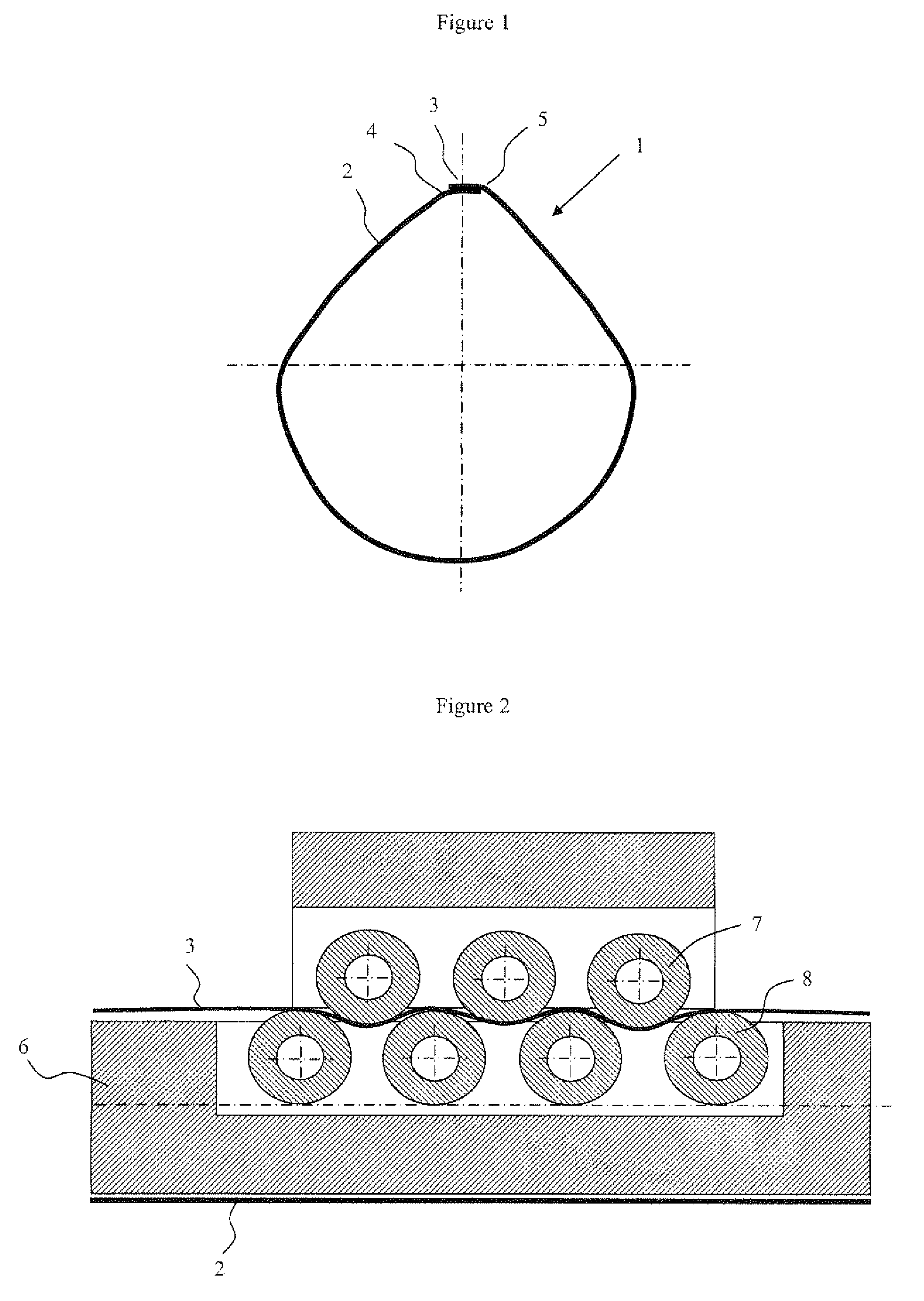Method for manufacturing tubes by welding
a manufacturing method and tube technology, applied in the direction of mechanical equipment, chemistry equipment and processes, other domestic objects, etc., can solve the problems of deformation of the skirt, particularly prejudicious to the joining and tube-filing operation, and the production of flexible tubes
- Summary
- Abstract
- Description
- Claims
- Application Information
AI Technical Summary
Benefits of technology
Problems solved by technology
Method used
Image
Examples
first embodiment
[0038]the invention consists of a welding method that includes an operation of elongating the welded zone in the longitudinal direction, i.e. in a direction perpendicular to the cross section of said tubular body. A first example for elongating the welded zone in a method in which the laminate moves at a constant speed over a welding rod, consists in varying the speed of the welding zone. This speed variation is obtained for example by means of a device made up of drive rollers located in the welding zone, the rotation speed differential of which has the effect of elongating the welded zone. A second example of the method and device for elongating the welded zone in the longitudinal direction is illustrated in FIG. 2. This device, inserted into a welding rod, is illustrated in a cross-sectional view of the welding rod 6, said cross-sectional view being parallel to the axis of the rod. This device is formed from a set of rollers 7 external to the rod and of rollers 8 housed in the ro...
second embodiment
[0039]the invention consists of a welding method that includes an operation of elongating the welded zone in the transverse direction, i.e. in a direction perpendicular to the axis of the tube. An example of a device for elongating the welded zone in the transverse direction is illustrated in FIG. 3. This device, inserted into a welding rod, is illustrated in a cross-sectional view of the welding rod 6, said cross section being perpendicular to the axis of the rod. This device is formed from a set of rollers 7 external to the rod and of rollers 8 housed in the rod which act together to elongate the welded zone 3. Only the welded zone 3 is elongated, the laminate 2 forming the tubular body not being deformed. The elongation of the welded zone 3 is adjusted via the pressure exerted by the rollers 7, said pressure having the effect of transversely elongating the welded zone 3. The number and diameter of the rollers 7 and 8 are adjusted according to the laminate and according to the wel...
third embodiment
[0040]the invention consists in elongating the welded zone 3 longitudinally and transversely. The third embodiment may be implemented by the sequential use of the devices illustrated in FIGS. 3 and 4. A device enabling simultaneous longitudinal and transverse elongation may also be used.
[0041]The first, second and third embodiments of the invention make it possible to compensate for the shrinkage of the welded zone during cooling and to prevent the shrinkage stresses that deform the tubular body. After elongation, the tubular body, the temperature of which is preferably uniform over its entire circumference, is cooled to the ambient temperature uniformly. This results in a tubular body having no out-of-roundness defect. The cross section of this tubular body is illustrated in FIG. 5, in which the out-of-roundness defects close to the welding zone 3 have been eliminated.
[0042]In a manufacturing method in which the laminate is not moving during the welding operation, many devices appl...
PUM
| Property | Measurement | Unit |
|---|---|---|
| Temperature | aaaaa | aaaaa |
| Temperature | aaaaa | aaaaa |
| Temperature | aaaaa | aaaaa |
Abstract
Description
Claims
Application Information
 Login to View More
Login to View More - R&D
- Intellectual Property
- Life Sciences
- Materials
- Tech Scout
- Unparalleled Data Quality
- Higher Quality Content
- 60% Fewer Hallucinations
Browse by: Latest US Patents, China's latest patents, Technical Efficacy Thesaurus, Application Domain, Technology Topic, Popular Technical Reports.
© 2025 PatSnap. All rights reserved.Legal|Privacy policy|Modern Slavery Act Transparency Statement|Sitemap|About US| Contact US: help@patsnap.com



